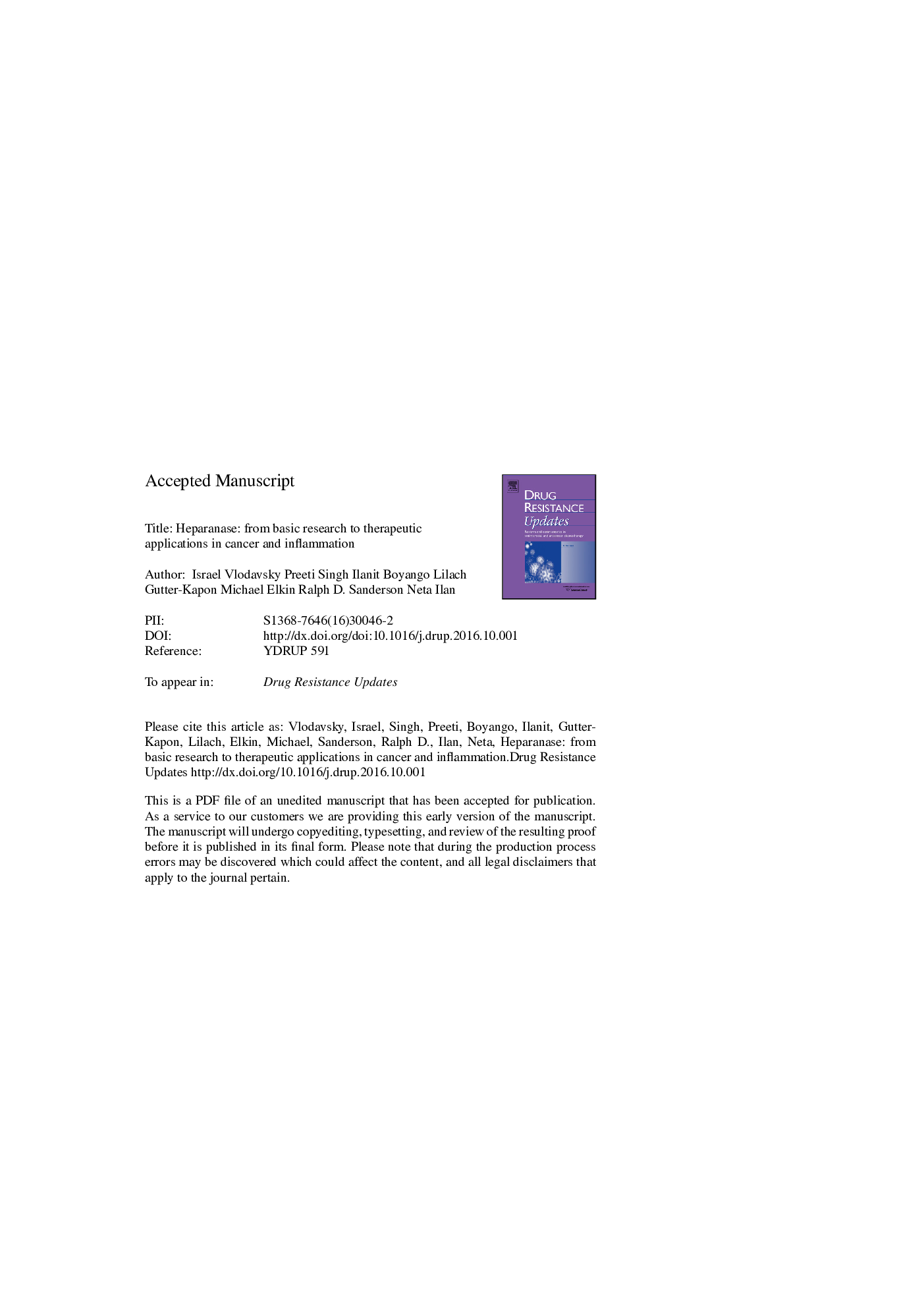| کد مقاله | کد نشریه | سال انتشار | مقاله انگلیسی | نسخه تمام متن |
|---|---|---|---|---|
| 8436651 | 1546834 | 2016 | 61 صفحه PDF | دانلود رایگان |
عنوان انگلیسی مقاله ISI
Heparanase: From basic research to therapeutic applications in cancer and inflammation
ترجمه فارسی عنوان
هپارناز: از تحقیقات پایه به برنامه های درمانی در سرطان و التهاب
دانلود مقاله + سفارش ترجمه
دانلود مقاله ISI انگلیسی
رایگان برای ایرانیان
کلمات کلیدی
موضوعات مرتبط
علوم زیستی و بیوفناوری
بیوشیمی، ژنتیک و زیست شناسی مولکولی
تحقیقات سرطان
چکیده انگلیسی
Heparanase, the sole heparan sulfate degrading endoglycosidase, regulates multiple biological activities that enhance tumor growth, angiogenesis and metastasis. Heparanase expression is enhanced in almost all cancers examined including various carcinomas, sarcomas and hematological malignancies. Numerous clinical association studies have consistently demonstrated that upregulation of heparanase expression correlates with increased tumor size, tumor angiogenesis, enhanced metastasis and poor prognosis. In contrast, knockdown of heparanase or treatments of tumor-bearing mice with heparanase-inhibiting compounds, markedly attenuate tumor progression further underscoring the potential of anti-heparanase therapy for multiple types of cancer. Heparanase neutralizing monoclonal antibodies block myeloma and lymphoma tumor growth and dissemination; this is attributable to a combined effect on the tumor cells and/or cells of the tumor microenvironment. In fact, much of the impact of heparanase on tumor progression is related to its function in mediating tumor-host crosstalk, priming the tumor microenvironment to better support tumor growth, metastasis and chemoresistance. The repertoire of the physio-pathological activities of heparanase is expanding. Specifically, heparanase regulates gene expression, activates cells of the innate immune system, promotes the formation of exosomes and autophagosomes, and stimulates signal transduction pathways via enzymatic and non-enzymatic activities. These effects dynamically impact multiple regulatory pathways that together drive inflammatory responses, tumor survival, growth, dissemination and drug resistance; but in the same time, may fulfill some normal functions associated, for example, with vesicular traffic, lysosomal-based secretion, stress response, and heparan sulfate turnover. Heparanase is upregulated in response to chemotherapy in cancer patients and the surviving cells acquire chemoresistance, attributed, at least in part, to autophagy. Consequently, heparanase inhibitors used in tandem with chemotherapeutic drugs overcome initial chemoresistance, providing a strong rationale for applying anti-heparanase therapy in combination with conventional anti-cancer drugs. Heparin-like compounds that inhibit heparanase activity are being evaluated in clinical trials for various types of cancer. Heparanase neutralizing monoclonal antibodies are being evaluated in pre-clinical studies, and heparanase-inhibiting small molecules are being developed based on the recently resolved crystal structure of the heparanase protein. Collectively, the emerging premise is that heparanase expressed by tumor cells, innate immune cells, activated endothelial cells as well as other cells of the tumor microenvironment is a master regulator of the aggressive phenotype of cancer, an important contributor to the poor outcome of cancer patients and a prime target for therapy.
ناشر
Database: Elsevier - ScienceDirect (ساینس دایرکت)
Journal: Drug Resistance Updates - Volume 29, November 2016, Pages 54-75
Journal: Drug Resistance Updates - Volume 29, November 2016, Pages 54-75
نویسندگان
Israel Vlodavsky, Preeti Singh, Ilanit Boyango, Lilach Gutter-Kapon, Michael Elkin, Ralph D. Sanderson, Neta Ilan,
